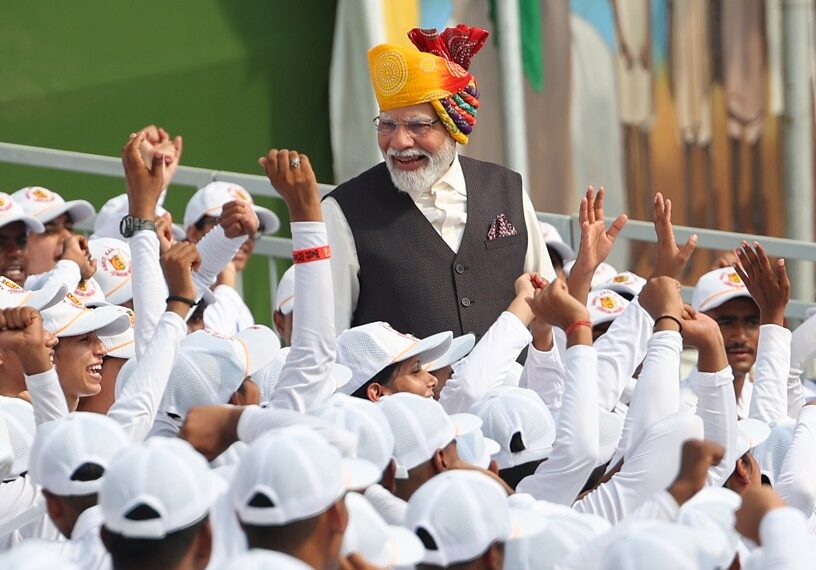By Satish K Jha
India’s parliamentary election is no longer the one-horse race many had initially imagined.
The National Democratic Alliance, led by Prime Minister Narendra Modi’s Bharatiya Janata Party (BJP), is being challenged by the Indian National Democratic and Inclusive Alliance (INDIA), a grouping of opposition parties.
The 2024 general election has turned into a highly localised affair. This helps Modi’s adversaries.
It seems regional parties will play a decisive role in the contests taking place in various states. If the Modi juggernaut is halted, the regional parties are likely to have the last laugh.
Modi’s electoral applecart is being upset in five ways:
Regional parties have regained their mojo
The regional parties are rejuvenated after a decade of hibernation and are putting up a good fight in their zones of influence. In the last two general elections of 2014 and 2019, they could not stop the Modi-led BJP. But this time around, they have regained their mojo.
Regional parties in India have a chequered history.
India being a federal polity, some parties rose on the plank of regional deprivation and sub-nationalism laced with caste and ethnic considerations.
However, many others were products of the socialist movement of the 1950s and 1960s. They got a new lease of life after the implementation of the Mandal Commission recommendations for reservations in government jobs for the socially and economically backward classes (largely equated with backward castes) in 1990.
There are also Dalit (downtrodden or the castes listed in the Indian Constitution) political parties. They stand for Dalit empowerment and are tied to the political ideologies of social reformers like Jyotiba Phule and B R Ambedkar.
Then there are groups that have split from the Congress over personal and local issues. They exist in Bengal, Maharashtra and Andhra Pradesh. There are also ethnic regional parties which are prominent in Maharashtra, Tamil Nadu, Kashmir, Sikkim and the other northeastern states.
The Aam Aadmi Party ruling Delhi and Punjab is an outlier among the regional parties. Though a product of an anti- corruption movement, it is a party with a neutral ideology and social identity which always looks for an opening wherever the BJP and Congress slip.
Most regional parties share two qualities: Barring those that splintered from the Congress, they are products of mass movements and they use identities — regional, linguistic, cultural and ethnic — to mobilise people.
Modi’s slogan of “400-plus” seats boomerangs
Modi’s electioneering, based on the slogan of “Abki baar, 400 paar (this time around, 400-plus seats)”, in the 545-member Parliament has backfired. It has boomeranged as it has created apprehensions that the Modi-led BJP is eyeing a brute majority to change the Constitution.
Marginalised sections of society like Dalits, tribals, backward classes and other minorities fear that the constitutional guarantees of special rights, privileges and protections they enjoy may be taken away.
In the communal fear of constitutional change, the caste-based regional parties that have been struggling against the BJP have suddenly found a campaign issue to galvanise their constituency.
The Congress party, weakened and demoralised under Rahul Gandhi, has been advocating a countrywide caste survey and joined the chorus. It too claims that a third term for Modi would mean the end of constitutional democracy in India and the scrapping of reservations.
Modi has been put on the back foot — reduced to issuing denials and explanations.
Opposition unity prevents vote division in most states
In the past, the divided opposition votes in the states tended to hobble the performance of regional parties against Modi. However, this time around, the formation of the INDIA bloc has ensured that the opposition parties have put up a one-to-one fight in most states against the BJP.
The only major exceptions are Uttar Pradesh and West Bengal.
Despite the Opposition’s best efforts in Uttar Pradesh, the Bahujan Samaj Party of Mayawati refused to align with the Congress and the Samajwadi Party. In West Bengal, Mamata Banerjee’s Trinamool Congress walked out of the opposition alliance and decided to go it alone.
Backward caste parties field “most backward caste” candidates
In this election, the pro-reservation regional parties in the northern states of Bihar and Uttar Pradesh have tried to check the fragmentation of the backward caste votes by fielding candidates from the non-dominant castes among them.
The caste-based parties of North India have also learned a lesson from earlier failures. They have fielded non-dominant and extremely backward castes in good numbers based on their presence at the constituency level. This neutralises BJP propaganda that these parties favour only the dominant sections among the backward castes.
Over the years, the BJP has used the bogey of caste majoritarianism within backward castes and Dalits and by dissolving these castes through co-option and representation. It paid good dividends in Uttar Pradesh, in particular.
However, this election will put this strategy of BJP to test because there is no Modi-wave in sight and there is no all-India campaign narrative at play. These two facts have made this general election a highly localised affair — varying from state to state, as well as within a state at the constituency level.
Anti-incumbency sentiment against NDA allies in the states
Modi has to bear the brunt of the anti-incumbency of his alliance partners in some states like Bihar. Also, given the low turnout in the initial phases of the election, an anti-incumbency swing against 10 years of Modi’s rule cannot be ruled out.
The electorate also seems upset with the BJP’s undemocratic shenanigans — capturing and toppling state governments by engineering wholesale defections of legislators and splitting opposition parties through inducements of power and pelf.
It seems that the BJP-led alliance is struggling hard to retain its 2019 victory tally. It has either failed to form alliances with important regional players (as in Tamil Nadu) or formed them with parties already on a downward slide (as in Karnataka and Bihar).
After many years, it seems that the regional parties hold the key to this election’s outcome. Their performance will decide whether they succeed in eroding the so-called “Modi magic”.
Satish K Jha is Associate Professor of Political Science at Aryabhatta College, Delhi University.
Originally published under Creative Commons by 360info™.















